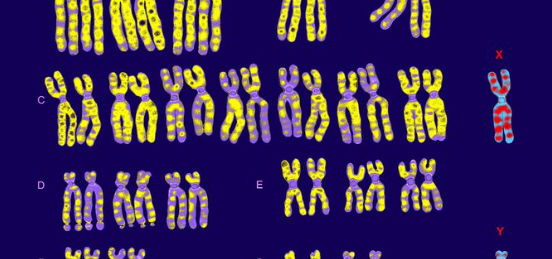Genetic Role: The Y chromosome is one of two sex chromosomes in humans, the other being the X chromosome. It is responsible for determining male sex characteristics, as it contains the SRY gene (Sex-determining Region Y), which triggers male development by initiating the formation of testes.
Size and Gene Content: The Y chromosome is significantly smaller than the X chromosome, containing around 50-60 million base pairs compared to the X chromosome’s 155 million base pairs. It has about 55-200 functional genes, many of which are involved in male sex determination and spermatogenesis (the production of sperm).
The sex of human babies, like other mammals, is typically determined by the Y chromosome, which carries a crucial male-determining gene. However, recent studies suggest that the human Y chromosome is gradually degenerating and may disappear in a few million years. This potential loss raises concerns about the future of human reproduction and survival unless a new sex-determining gene evolves.
The Y Chromosome Is Slowly Vanishing. A New Sex Gene May Be The Future of Men. https://t.co/PPw0OOVxuK pic.twitter.com/sxi0TqllGl
— DomPachino101 (@DomPachino101) August 22, 2024
Interestingly, some rodents have already lost their Y chromosome and yet have continued to thrive. For instance, the spiny rat, as documented in a 2022 study published in the Proceedings of the National Academy of Sciences, has developed a new male-determining gene, offering a glimpse into how species might adapt to the disappearance of the Y chromosome.
In humans, females typically have two X chromosomes, while males possess one X and one Y chromosome. Despite its small size and limited number of genes—around 55—the Y chromosome plays a critical role in male development. The key gene responsible for this is known as SRY (sex-determining region Y), which initiates the development of male characteristics in the embryo. Around 12 weeks after conception, SRY activates a genetic pathway involving the SOX9 gene, crucial for male determination across all vertebrates.
The Y chromosome, however, has been losing its genetic material over millions of years. Research comparing the Y chromosomes of mammals like the platypus suggests that the human Y chromosome has shed nearly 900 genes over 166 million years. At this rate, scientists predict that the remaining genes could vanish in about 11 million years, potentially leading to the extinction of humans unless new mechanisms for sex determination evolve.
Despite this grim outlook, some rodent species have already adapted to life without a Y chromosome. For example, mole voles in Eastern Europe and spiny rats in Japan have lost their Y chromosome and SRY gene entirely. In spiny rats, researchers discovered that most Y-linked genes had relocated to other chromosomes, and a small duplication near the SOX9 gene on chromosome 3 now triggers male development. This adaptation suggests that even if the Y chromosome disappears, other mechanisms could evolve to ensure the continuation of the species.
The potential disappearance of the Y chromosome in humans raises significant questions about our future. Without the Y chromosome, the human race could face extinction, as we rely on sperm and men for reproduction. However, the evolution of a new sex-determining gene, as seen in spiny rats, offers a hopeful alternative. Still, this evolution could come with risks, such as the emergence of multiple sex-determination systems, leading to the development of new human species that are reproductively isolated from one another.
Can happen actually. Y chromosome is disappearing… https://t.co/4y9FxUESCM
— Coronai (@em0clev) August 23, 2024
In 11 million years, humanity could face extinction or witness the rise of different human species, each with its unique sex-determination system. The future of human evolution remains uncertain, but these developments underscore the dynamic nature of genetics and the potential for adaptation.
More Information
- Inheritance: The Y chromosome is passed down patrilineally, meaning it is inherited exclusively from father to son. This inheritance pattern makes the Y chromosome a valuable tool for tracing paternal ancestry and studying population genetics.
- Degeneration and Evolution: Over evolutionary time, the Y chromosome has lost much of its genetic material and continues to degenerate. It is believed to have originally been the same size as the X chromosome but has shrunk over millions of years due to a lack of recombination with a partner chromosome.
- Variability: Despite its degeneration, the Y chromosome shows considerable variation among males, especially in the non-recombining regions. This variability is often used in studies of human migration and evolution.
- Y-Chromosome and Health: Mutations or deletions in certain parts of the Y chromosome can lead to health issues, particularly those related to male fertility, such as Y-chromosome microdeletions that are associated with low sperm count or azoospermia (absence of sperm).
- Myth of Extinction: There is a popular but controversial hypothesis suggesting that the Y chromosome may eventually disappear due to its degeneration. However, recent research suggests that this process has stabilized, and the Y chromosome may not be at risk of extinction as previously thought.
Major Points:
- The human Y chromosome, responsible for male sex determination, is gradually degenerating and may disappear in a few million years.
- Some rodents, like the spiny rat, have already lost their Y chromosome and evolved new sex-determining genes, showing that species can adapt to such changes.
- In humans, the Y chromosome carries the SRY gene, which triggers male development by activating the SOX9 gene during embryonic growth.
- The potential loss of the Y chromosome could lead to human extinction or the evolution of new sex-determining mechanisms, but with risks of developing multiple reproductive systems and new human species.
- The disappearance of the Y chromosome could result in either the extinction of humans or the emergence of different human species with distinct sex-determination systems in the distant future.
Susan Guglielmo – Reprinted with permission of Whatfinger News

